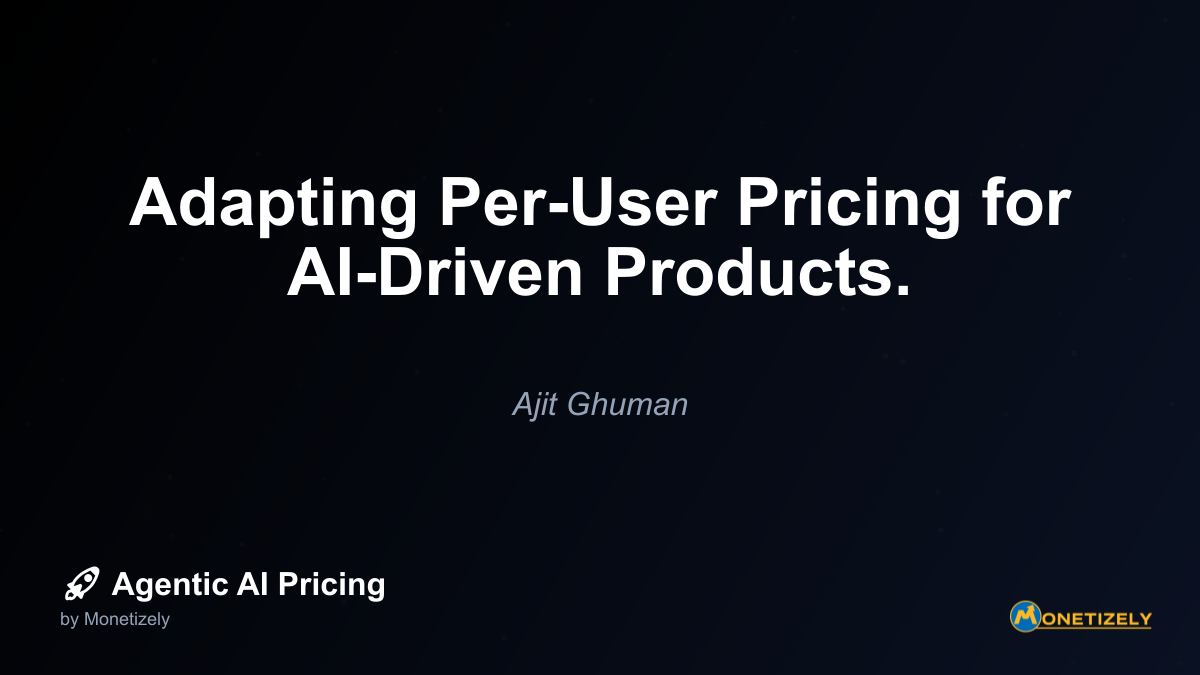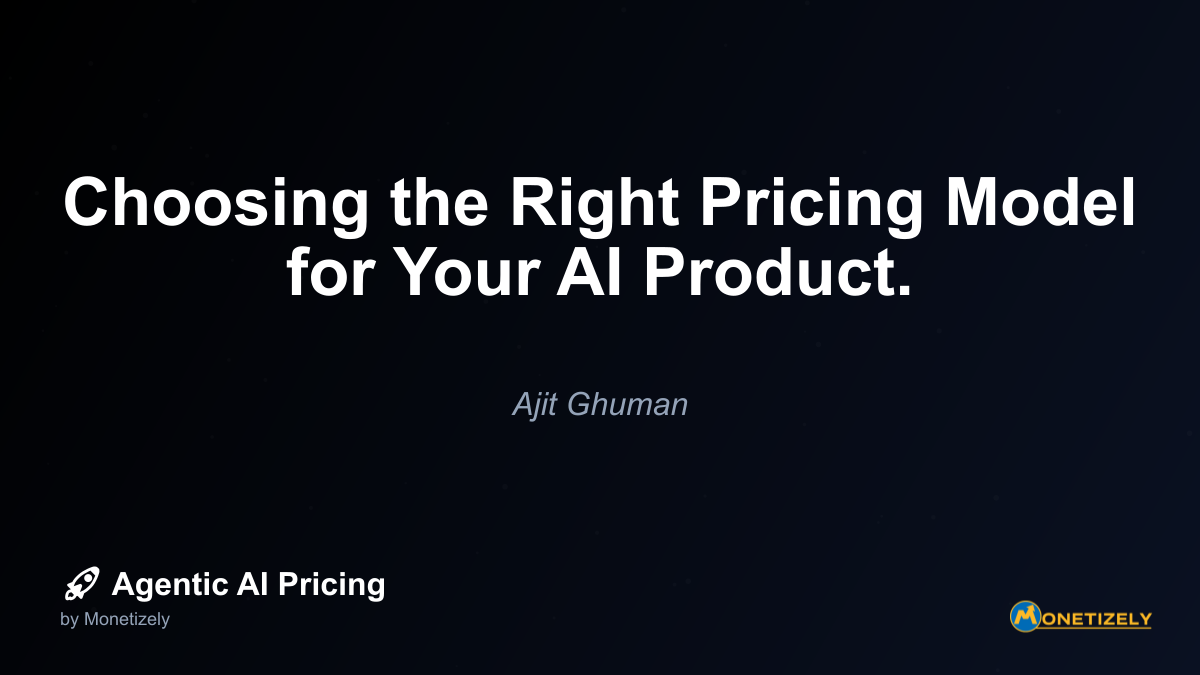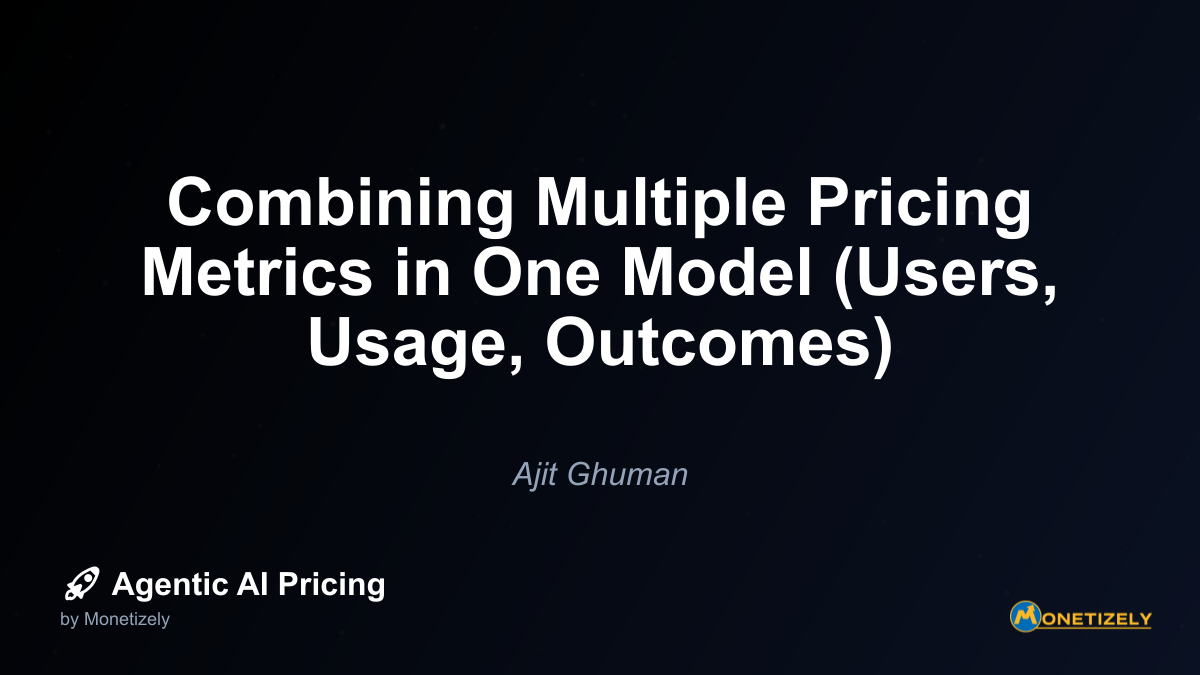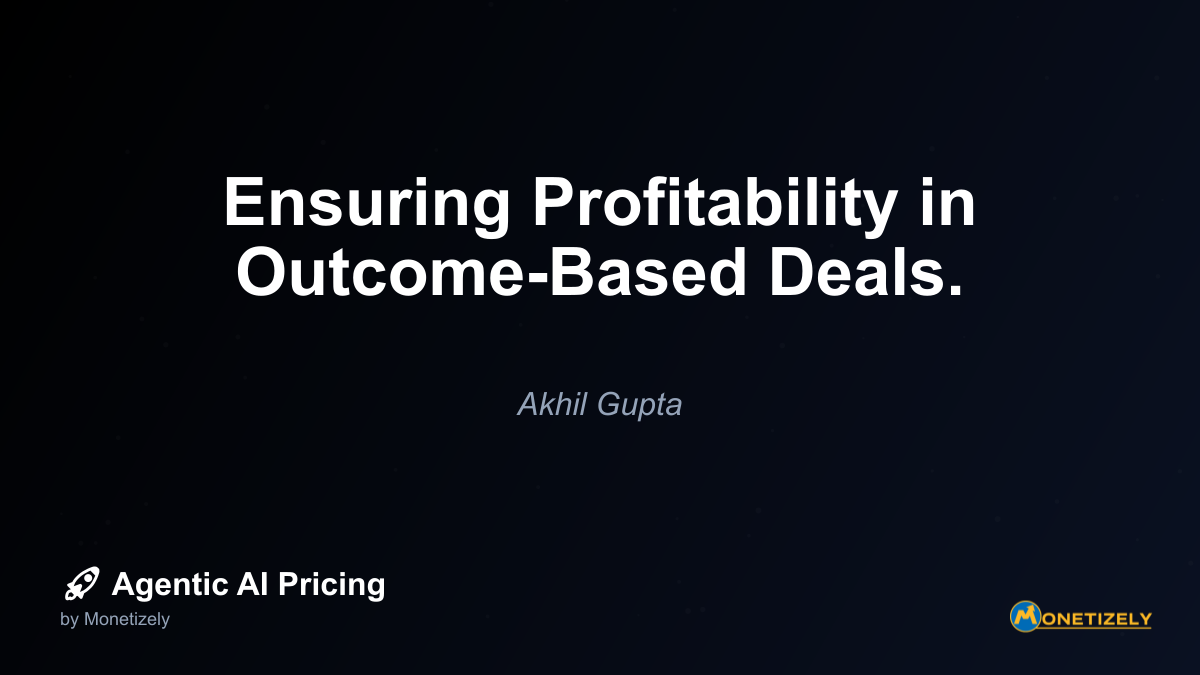· Akhil Gupta · Agentic AI Pricing Strategies · 8 min read
Hybrid Pricing Models: Combining Subscription and Usage.
AI and SaaS Pricing Masterclass
Learn the art of strategic pricing directly from industry experts. Our comprehensive course provides frameworks and methodologies for optimizing your pricing strategy in the evolving AI landscape. Earn a professional certification that can be imported directly to your LinkedIn profile.
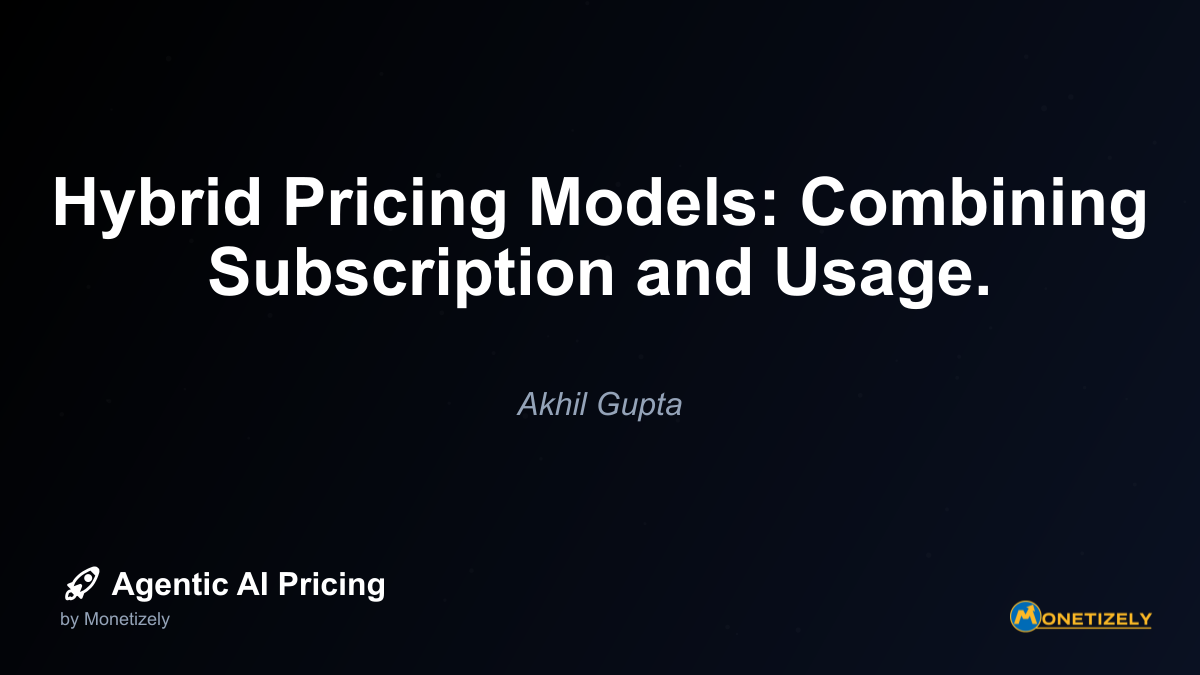
The evolution of pricing models has undergone significant transformation with the advent of agentic AI technologies. While traditional subscription-based or purely usage-based models have dominated the SaaS landscape for years, forward-thinking companies are increasingly adopting hybrid approaches that combine elements of both. These hybrid pricing models offer a compelling balance between predictable revenue streams and value-aligned pricing that scales with customer usage patterns.
Understanding Hybrid Pricing Models in Agentic AI
Hybrid pricing in the context of agentic AI refers to pricing structures that blend a fixed subscription component with variable usage-based elements. This approach provides businesses with baseline predictable revenue while allowing for additional monetization when customers derive greater value from the product through increased usage.
The most common implementation follows this pattern:
- A base subscription fee that grants access to the core platform
- An allocation of included usage (API calls, tokens, tasks, etc.)
- Overage charges that apply when usage exceeds the included threshold
This model has gained significant traction in the agentic AI space because it aligns well with how these systems are typically utilized. Customers receive a predictable monthly bill for standard usage patterns, while businesses can capture additional revenue from power users who derive exceptional value from the platform.
Why Hybrid Models Are Gaining Popularity in Agentic AI
The rise of hybrid pricing for agentic AI solutions stems from several key advantages that benefit both providers and customers:
1. Predictable Revenue Base
For providers, the subscription component establishes a minimum revenue threshold regardless of actual usage levels. This predictability supports financial planning, investor relations, and operational stability. According to recent industry data, companies with strong recurring revenue components typically command 2-3x higher valuations than those relying solely on transactional revenue.
2. Value-Based Scaling
The usage component ensures that pricing scales in proportion to the value customers extract from the platform. When an agentic AI system becomes increasingly valuable to a customer—perhaps by automating more processes or handling greater workloads—the provider participates in that success through higher usage fees.
3. Lower Barrier to Entry
Hybrid models often enable lower initial price points compared to all-inclusive subscriptions, reducing friction in the customer acquisition process. New users can start with modest commitments and scale their spending as they realize value and expand usage.
4. Alignment with Cost Structures
For many agentic AI providers, costs scale with usage (compute resources, API calls to foundation models, etc.). Hybrid pricing creates alignment between revenue and cost structures, protecting margins as usage increases.
Common Hybrid Pricing Structures for Agentic AI
Several variations of hybrid pricing have emerged in the agentic AI marketplace, each with distinct characteristics:
Tiered Subscription + Overage
This approach offers multiple subscription tiers with increasing amounts of included usage. When customers exceed their tier’s allocation, they pay overage charges until they reach the next tier’s threshold.
Example: An AI document processing agent might offer:
- Basic: $99/month with 1,000 pages included
- Professional: $249/month with 3,000 pages included
- Enterprise: $599/month with 10,000 pages included
- Overage: $0.05 per additional page
Base Platform + Feature-Specific Usage
Some providers charge a subscription for access to their core platform while implementing usage-based pricing only for specific high-value features or capabilities.
Example: An agentic AI marketing platform might charge:
- $499/month platform access fee
- $0.10 per AI-generated social media post
- $1.50 per AI-optimized email campaign
- $5.00 per comprehensive competitor analysis
Commitment-Based Hybrid Models
This approach requires customers to commit to a minimum spending level (subscription) while allowing flexible allocation across different usage categories, with overage charges for exceeding the commitment.
Example: An enterprise AI assistant might require:
- $5,000 monthly minimum commitment
- Flexible allocation across research, content creation, and data analysis
- 15% discount on the committed amount compared to on-demand rates
- Standard rates for usage beyond commitment
Implementing Effective Hybrid Pricing for Agentic AI
Successfully executing a hybrid pricing strategy requires careful consideration of several factors:
1. Determining the Right Balance
Finding the optimal ratio between subscription and usage components is critical. Too much emphasis on the subscription can limit adoption, while too much weight on usage creates revenue uncertainty.
For early-stage agentic AI products, many companies start with a 70/30 split (70% of expected revenue from subscriptions, 30% from usage) to establish revenue stability while testing usage-based components.
2. Setting Appropriate Usage Allocations
The included usage allocation within each subscription tier should satisfy the needs of typical customers in that segment while encouraging upgrades for those approaching the limits.
Analysis of customer usage patterns often reveals natural breakpoints that can inform these allocations. Many successful providers position their middle tier to cover approximately 80% of typical customer usage, with entry tiers covering 50-60%.
3. Pricing Overage Charges
Overage rates require careful calibration. Set them too high, and customers may feel penalized; set them too low, and you risk undermonetizing high-value usage.
A common approach is to price overages at a 10-30% premium compared to the effective per-unit rate within the subscription tier. This creates a moderate incentive to upgrade to higher tiers without feeling punitive.
4. Transparent Communication
Clear communication about how the pricing model works is essential for customer acceptance. Dashboards showing usage relative to allocations, proactive notifications about approaching limits, and simple explanations of how charges are calculated all contribute to customer comfort with hybrid models.
Real-World Examples of Hybrid Pricing in Agentic AI
Several leading companies in the agentic AI space have implemented successful hybrid pricing approaches:
OpenAI’s API Pricing
While not strictly an agentic AI product itself, OpenAI’s API pricing for models like GPT-4 illustrates hybrid principles that many agentic AI solutions built on these models adopt:
- Access requires a subscription starting at $20/month
- This includes a certain allocation of tokens
- Additional usage is charged based on input/output tokens
- Enterprise tiers include higher allocations with volume discounts on overages
GitHub Copilot
GitHub’s AI programming assistant uses a hybrid approach:
- Individual users: Fixed subscription of $10/month or $100/year
- Business users: $19/user/month with enterprise features
- Usage limits apply with potential throttling for excessive use
- Enterprise plans include higher usage thresholds
Jasper AI
This content generation platform employs a sophisticated hybrid model:
- Subscription tiers based on user seats and included words
- Creator: $39/month with 50,000 words included
- Teams: $99/month with 100,000 words included
- Business: Custom pricing with negotiated word allocations
- Additional words available at rates that decrease with volume
Challenges and Considerations for Hybrid Pricing
While hybrid models offer numerous advantages, they also present specific challenges that require attention:
1. Complexity in Communication
Hybrid models are inherently more complex than pure subscription or usage-based approaches. This complexity can create friction in the sales process and confusion for customers trying to estimate costs.
Solution: Invest in clear pricing pages, interactive calculators that help prospects estimate costs based on expected usage patterns, and transparent reporting tools that help customers understand their charges.
2. Revenue Forecasting Difficulties
The variable component of hybrid models introduces uncertainty into revenue projections, which can complicate financial planning and investor relations.
Solution: Develop sophisticated usage forecasting models based on historical patterns and cohort analysis. Many mature companies can predict usage-based revenue within 5-10% accuracy after collecting sufficient historical data.
3. Billing System Requirements
Implementing hybrid pricing requires billing systems capable of tracking usage, calculating overages, and presenting clear invoices that explain all charges.
Solution: Evaluate specialized billing platforms like Chargebee, Recurly, or Stripe Billing that support hybrid models rather than attempting to build custom solutions that can become maintenance-intensive.
4. Customer Budget Concerns
The unpredictability of final charges can create budget concerns for customers, particularly in enterprise contexts where fixed budgets are allocated in advance.
Solution: Offer usage caps or budget limits that customers can set to prevent unexpected charges, with optional alerts when approaching thresholds.
Optimizing Hybrid Models Through Experimentation
The most successful implementers of hybrid pricing treat their models as ongoing experiments rather than static structures. Consider these approaches to continuous optimization:
1. A/B Testing Different Allocations
Test different included usage allocations across customer segments to identify the optimal balance that maximizes both adoption and revenue.
2. Cohort Analysis
Track how different customer cohorts respond to pricing changes over time, particularly focusing on expansion revenue and churn rates as indicators of pricing-value alignment.
3. Willingness-to-Pay Research
Conduct regular research to understand how willingness-to-pay evolves as the agentic AI category matures and customer value perception changes.
4. Competitive Benchmarking
Monitor competitor pricing structures to ensure your hybrid model remains competitive while appropriately valuing your unique capabilities.
The Future of Hybrid Pricing in Agentic AI
As agentic AI continues to evolve, we can anticipate several trends in hybrid pricing approaches:
1. Outcome-Based Components
Future hybrid models may incorporate outcome-based pricing elements where charges are partially tied to measurable business results rather than just raw usage.
2. Dynamic Allocation Adjustments
More sophisticated systems will automatically adjust usage allocations based on seasonal patterns or business cycles, optimizing the model for each customer’s unique situation.
3. AI-Optimized Pricing
Ironically, agentic AI itself will increasingly be applied to optimize pricing models, analyzing vast datasets of usage patterns and customer behaviors to suggest optimal pricing structures.
4. Multi-Dimensional Hybrid Models
Rather than simple subscription-plus-usage approaches, we’ll see more complex models that incorporate multiple usage dimensions, feature-specific charges, and outcome-based components in sophisticated combinations.
Conclusion
Hybrid pricing models represent a powerful approach for agentic AI solutions, balancing the predictability of subscriptions with the value-alignment of usage-based pricing. When thoughtfully designed and clearly communicated, these models can drive customer acquisition through accessible entry points while enabling revenue expansion as usage and value increase.
For businesses developing or deploying agentic AI solutions, hybrid pricing deserves serious consideration as part of the go-to-market strategy. The key to success lies in finding the right balance between fixed and variable components, setting appropriate usage allocations, and maintaining transparent communication with customers about how the model works.
As the agentic AI market continues to mature, we can expect hybrid pricing models to evolve in sophistication, potentially incorporating outcome-based elements and leveraging AI itself to optimize pricing structures. Organizations that master this approach will be well-positioned to build sustainable businesses that grow in tandem with the value they deliver to customers.
Co-Founder & COO
Akhil is an Engineering leader with over 16+ years of experience in building, managing and scaling web-scale, high throughput enterprise applications and teams. He has worked with and led technology teams at FabAlley, BuildSupply and Healthians. He is a graduate from Delhi College of Engineering and UC Berkeley certified CTO.
Pricing Strategy Audit
Let our experts analyze your current pricing strategy and identify opportunities for improvement. Our data-driven assessment will help you unlock untapped revenue potential and optimize your AI pricing approach.

